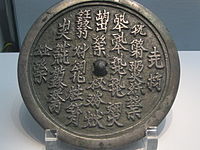Khitan script
| Khitan scripts |
|
|---|---|

Bronze mirror with a Khitan small script inscription
|
|
| Type | |
| Languages | Khitan language |
|
Parent systems
|
Oracle Bone Script
|
|
Child systems
|
Jurchen script |
|
Sister systems
|
Simplified Chinese, Kanji, Hanja, Chữ Nôm, Zhuyin |
The Khitan scripts were the writing systems for the now-extinct para-Mongolian Khitan language used in the 10th-12th century by the Khitan people who had established the Liao dynasty in Northeast China. There were two scripts, the large script and the small script. These were functionally independent and appear to have been used simultaneously. The Khitan scripts continued to be in use to some extent by the Jurchen people for several decades after the fall of the Liao dynasty until the Jurchens fully switched to a script of their own. Examples of the scripts appeared most often on epitaphs and monuments, although other fragments sometimes surface.
Many scholars recognize that the Khitan scripts have not been fully deciphered and that more research and discoveries would be necessary for a proficient understanding of them. The Khitan scripts are part of the Chinese family of scripts.
Knowledge of the Khitan language, which was written by the Khitan script, is quite limited as well. Although there are several clues to its origins, which might point in different directions, the Khitan language shares an ancestor with the Mongolian languages but is not one.
Abaoji of the Yelü clan, founder of the Khitan, or Liao Dynasty, introduced the original Khitan script in 920 CE. “Large script”, or “big characters" (大字), as it was referred to in some Chinese sources, was established to keep the record of the new Khitan state. The Khitan script was based on the idea of the Chinese script.
The Khitan large script was considered to be relatively simple. The large script characters were written equally spaced, in vertical columns, in the same way as the Chinese has been traditionally written. Although large script mostly uses logograms, it is possible that ideograms and syllabograms are used for grammatical functions. The large script has a few similarities to Chinese, with several words taken directly with or without modifications from the Chinese (e.g. characters 二,三,十,廿,月,日, which appear in dates in the apparently bilingual Xiao Xiaozhong muzhi inscription from Xigushan, Jinxi, Liaoning Province). Most large script characters, however, cannot be directly related to any Chinese characters. The meaning of most of them remains unknown, but that of a few of them (numbers, symbols for some of the five elements and the twelve animals that the Khitans apparently used to designate years of the sexagenary cycle) has been established by analyzing dates in Khitan inscriptions.
...
Wikipedia
